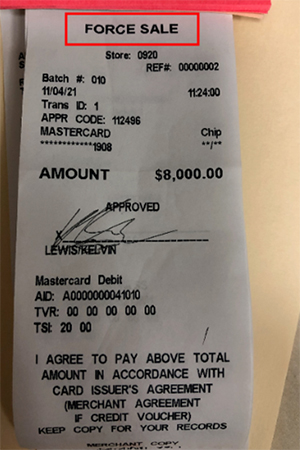I JUST RECEIVED A call for a jeweler I help a lot about how they got “snookered” out of an $8,000 gold bracelet. Here’s what happened.
1. Two older men come in, look around and “eye” the heavy gold bracelet.
2. Next day, two young white men come in the store. One’s on his cell phone talking, for distraction.
3. The other looks at and buys the bracelet with a DEBIT CARD. Most debit cards have a maximum spendable limit anywhere between $2,000 and $7,000. They run the card in the machine for $8,000, and of course it’s declined. The young man says, “Happens all the time, let ME call the credit card company,” and he calls a bogus phone number, which happens to be his friend who has rehearsed this.
4. He then hands the phone to the associate, saying “Here, they have a code for you.”
 5. The bogus friend gives them a bogus authorization code, but it GOES THROUGH and prints a receipt (see image).
5. The bogus friend gives them a bogus authorization code, but it GOES THROUGH and prints a receipt (see image).
6. Staff thinks it’s all OK and everyone is good. But the owner is suspicious, follows the guy out of the store who walks a block, takes a right and gets in a waiting car.
7. They do have cameras and photocopies of the driver’s license (I hope to share this as soon as I get a copy).
They called the credit card processor who said, “Oh, this is the biggest scam going, you can Google how to do this in a store.”
How can you make sure you’re not “snookered”?
SIMPLE: The store calls the credit card processor phone number they gave you when you got your processor. NEVER let the customer call and tell you it’s the credit card company and hand you the phone.
Here’s a full description of the scam from the due.com blog:
Force Authorization Scam
When a customer’s card is declined, a merchant can perform a “force auth” to complete the transaction. A merchant typically conducts a force auth because they have already remitted goods or services and want to finalize the sale. To force a transaction, the merchant calls the cardholder’s issuing bank to obtain an authorization code to override the decline.
Advertisement
In a forced sale, any combination of digits forming the “code” will override the denial. When a customer presents a card that is declined, they tell the clerk “this happens all the time” and instruct them to enter a combination of alpha numeric characters.
If the clerk enters the fake authorization code instead of calling the cardholder’s issuing bank to obtain a valid code, the transaction will go through. However, the merchant assumes all the risk. If the auth code is fraudulent, the merchant will not be able to file a dispute. They will also be subject to costly chargebacks and fines.
Never enter a code given by a cardholder to force a transaction. Always allow the terminal to get an approval code.
Looks like they may use a debit card on a legitimate purchase, give the authorization code from that purchase to the friend on the phone, and because that’s a legitimate code, it goes through again. But you won’t get your money, although the receipt prints.
Always call the processor phone number you have on file.